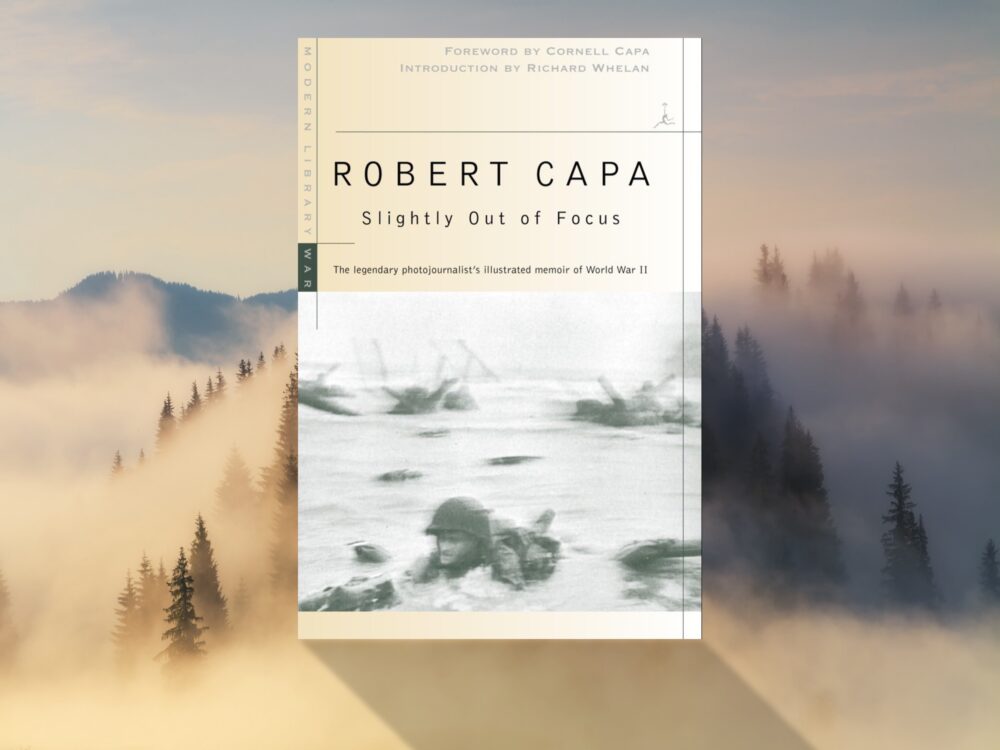Overview
‘Slightly Out of Focus’ is a memoir by the legendary photojournalist Robert Capa, chronicling his experiences during World War II. The book captures Capa’s journey from 1942, when he was assigned by Collier’s magazine to photograph the war in Europe. Through his vivid storytelling, Capa recounts his terrifying and often humorous adventures across various battlefields, from Sicily to Normandy and beyond. His narrative is filled with personal anecdotes about the soldiers and civilians he encountered, providing a deeply human perspective on the war.
What makes this book particularly special is the richness of Capa’s photography. Known as one of the greatest battlefield photographers of the 20th century, Capa’s images are both powerful and poignant. His ability to capture motion, emotion, and the stark realities of war is unparalleled. The photographs in “Slightly Out of Focus” are not just illustrations but integral parts of the narrative, bringing his written words to life and offering readers a profound visual experience.
Synopsis
Throughout the book, Capa’s personal stories intertwine with the larger events of WWII, providing a unique perspective on the war. His relationships with fellow correspondents, soldiers, and civilians bring a human element to the historical narrative.
The essence of the eighteen chapters can be captured as follows:
- Chapter 1-3: Capa begins his journey in 1942, traveling to England. He describes the initial chaos and excitement of being assigned to cover the war. His personal anecdotes about meeting other correspondents and soldiers set the stage for the human side of the conflict.
- Chapter 4-6: These chapters cover Capa’s time in North Africa, where he captures the harsh realities of desert warfare. His interactions with soldiers reveal their fears and hopes, providing a poignant backdrop to the brutal battles.
- Chapter 7-9: Capa moves to Sicily and Italy, documenting the Allied invasion. His photographs and stories from this period highlight the resilience of both soldiers and civilians amidst the devastation.
- Chapter 10-12: The focus shifts to the D-Day landings in Normandy. Capa’s iconic photographs from Omaha Beach are a testament to the chaos and heroism of that day. His personal reflections on the friends he lost and the horrors he witnessed add depth to his narrative.
- Chapter 13-15: As the Allies push through France, Capa captures the liberation of Paris. His joy at returning to the city he loves is tempered by the memories of the war’s toll on its people.
- Chapter 16-18: The final chapters cover the Battle of the Bulge and the push into Germany. Capa’s photographs from this period are some of his most powerful, showing both the destruction and the hope for peace.
Why you should read it?
The book is an intriguing and significant read because it offers a firsthand account of World War II from one of the most renowned photojournalists of the 20th century.
Capa’s vivid storytelling and powerful photographs provide a visceral experience of the war, capturing both the chaos of battle and the humanity of those involved. His personal anecdotes and reflections give readers a unique perspective on the events that shaped the modern world, making history come alive in a way that textbooks often cannot.
As the generation that witnessed World War II is slowly disappearing, recent generations have fewer personal connections to these historical events. This makes Capa’s memoir even more important, as it serves as a bridge to the past, preserving the memories and lessons of the war.
By reading “Slightly Out of Focus,” younger generations can gain a deeper understanding of the sacrifices made and the horrors endured, ensuring that the significance of these events is not forgotten. This book not only educates but also fosters empathy and a greater appreciation for the peace and freedoms we enjoy today.
Critics and review
The book was first published in 1947 by Henry Holt. At the time of its release, the book was well-received for its candid and vivid portrayal of World War II through the eyes of a renowned photojournalist. Capa’s ability to blend humor with the grim realities of war, along with his compelling photographs, made the memoir stand out. Critics and readers appreciated the raw and unfiltered look at the war, which was still fresh in the public’s memory.
Recent reviews continue to praise the book for its powerful storytelling and historical significance. Modern readers find Capa’s firsthand account and his iconic photographs to be both educational and emotionally impactful. The memoir is often highlighted for its ability to bring history to life, making it a valuable read for those interested in World War II and photojournalism. Some reviews note that Capa’s charismatic personality and unique perspective add depth to the narrative, making it a timeless piece that resonates even with contemporary audiences.
Verdict
The book is a compelling and essential read that masterfully combines vivid storytelling with powerful photography. Capa’s firsthand account, filled with personal anecdotes and iconic images, brings the horrors and humanity of the war to life. As the generation that witnessed these events fades, this memoir serves as a crucial bridge to the past, ensuring that the lessons and sacrifices of the war are not forgotten. It’s a timeless piece that resonates deeply with both historical enthusiasts and general readers.
About the authors
Robert Capa, born Endre Ernő Friedmann in Budapest in 1913, led an adventurous and impactful life as one of the most renowned war photographers of the 20th century. Fleeing political repression in Hungary at the age of 18, he moved to Berlin and later to Paris, where he adopted the name Robert Capa.
His career took off during the Spanish Civil War, and he went on to cover five major conflicts, including World War II, where he captured some of the most iconic images of the D-Day landings. Capa’s personal life was equally colourful; he had a notable relationship with actress Ingrid Bergman, following her to Hollywood in 1945. Their romance, though brief, was intense and even inspired Alfred Hitchcock’s film “Rear Window”.
Capa’s life was tragically cut short in 1954 when he stepped on a landmine while covering the First Indochina War, fully embodying his belief that “if your pictures aren’t good enough, you’re not close enough.” His death cemented his legacy as a fearless photojournalist. Despite his early struggles, including escaping Hungary and facing the rise of Nazism in Germany, Capa co-founded the Magnum Photos agency in 1947 with Henri Cartier-Bresson and others, creating a cooperative that would support freelance photographers worldwide. His work and life continue to inspire and influence the field of photojournalism.









Leave a Reply